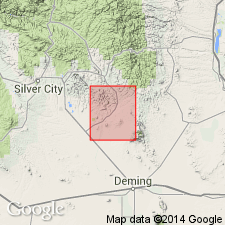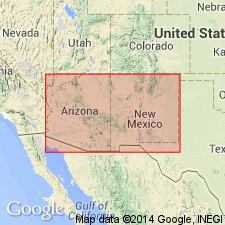
- Usage in publication:
-
- Caballo Blanco rhyolite tuff
- Modifications:
-
- Original reference
- Dominant lithology:
-
- Tuff
- AAPG geologic province:
-
- Basin-and-Range province
Summary:
Pg. 17 (table 1), 30-31, 32, pl. 1. Caballo Blanco rhyolite tuff. Described as white, cream, or light-gray porphyritic rhyolite tuff interpreted as an ignimbrite. Matrix partly pumiceous. Reaches maximum thickness of 325 feet at Caballo Blanco in Dwyer quadrangle; thins to the west and pinches out toward the south near Box Well. According to generalized stratigraphic section Caballo Blanco rhyolite tuff is uppermost unit of eruptive suite termed Lower Volcanic series. Occurs above Rustler Canyon basalt (new). Unconformably underlies Razorback andesite and rhyolite of Upper Volcanic series. Age is Tertiary. Origin of name stated.
Named from Caballo Blanco Mountain [Whitehorse Mountain], in secs. 25 and 36, T. 18 S., R. 11 W., [Grant Co.], Dwyer 15-min quadrangle, southwestern NM.
Source: US geologic names lexicon (USGS Bull. 1200, p. 564-565).

- Usage in publication:
-
- Caballo Blanco Rhyolite
- Modifications:
-
- Paleomagnetics
- AAPG geologic province:
-
- Basin-and-Range province
Summary:
In the Dwyer quad, southeast of Silver City, Grant Co, NM, Basin-and-Range province, Caballo Blanco Rhyolite and Box Canyon Rhyolite ash-flow tuffs are both reversely magnetized. The Caballo Blanco has been dated at 29.8 m.y. Beneath this is the very striking Mimbres Peak flow-banded rhyolite, which is normally magnetized. Magnetostratigraphic position of Caballo Blanco, Box Canyon, and Mimbres Peak units within a preliminary model of the middle Tertiary paleomagnetic reversal pattern is depicted on fig. 4.
Source: GNU records (USGS DDS-6; Denver GNULEX).
For more information, please contact Nancy Stamm, Geologic Names Committee Secretary.
Asterisk (*) indicates published by U.S. Geological Survey authors.
"No current usage" (†) implies that a name has been abandoned or has fallen into disuse. Former usage and, if known, replacement name given in parentheses ( ).
Slash (/) indicates name conflicts with nomenclatural guidelines (CSN, 1933; ACSN, 1961, 1970; NACSN, 1983, 2005, 2021). May be explained within brackets ([ ]).

